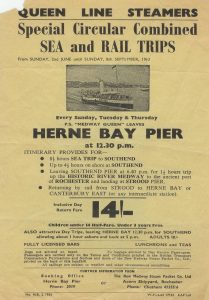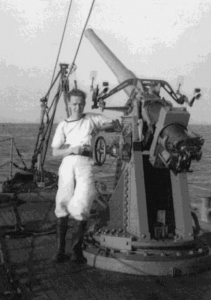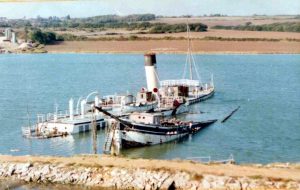‘THE HEROINE OF DUNKIRK’
On St George’s Day 1924, the New Medway Steam Packet’s newest passenger paddle steamer, The Medway Queen, set of on her first voyage.
Nobody that day could have predicted the incredible 96-year journey she had just set out on.
Commissioned to be built by the Scottish ship building company Alisa in 1923 as part of the New Medway Steam Packets brand new Queen line, The Medway Queen took just 8 months to be built.
“They didn’t hang about in those days they just got lots of blokes with hammers and built ships quickly.” Richard Halton tells us, chuckling down the phone.
Richard is a trustee of The Medway Queen Preservation Society, raising £90,000 for the charity having been involved with the organisation since 1986.
In addition to this, he also authored ‘The Medway Queen’, which details the long and storied history of the ship.

In her early years, The Medway Queen would make between two and three return trips a day from a Medway port to Southend.
It was on one of these trips in 1929 that she collided with Southend pier, suffering extensive damage, but she was back in service in no time.
This was just the first of many times that she would have come back from the brink over the years.
The Queen was just one of hundreds of paddle steamers on English waterways at the time.
A day trip on a paddle steamer was a summer holiday institution in the early to mid-twentieth century.
“I went on the boat once as a teenager and it was the highlight of the holiday.
“You’ve got to remember this was before people went on packages to all sorts of places warmer and dryer than the British seaside.” Richard explains to us.
However, the good times weren’t to last.
The outbreak of World War 2 would see the Queen thrust into the services of the Royal Navy, first transporting evacuees to the countryside and then being converted to a minesweeper in the winter of 1939.
This was dangerous work, especially for a passenger ship as small as The Medway Queen.
“She’s lightly built and, in the war, of course she was used as a minesweeper and you’ve got to think of yourself on board Medway Queen and you’ve only got about a quarter of inch of steel between you and what goes bang on the outside it’s not a lot is it?” Richard informs us.
Minesweeping wouldn’t be the only way the Medway Queen would make a significant contribution to the war effort.
Just before seven o’clock on the evening of 26th of May 1940, Operation Dynamo, better known as The Dunkirk Evacuation, would be launched and The Medway Queen would forever immortalise herself as one of the little boats of Dunkirk.

Over eight thousand boats scrambled to rescue the 300,000 Soldiers stranded on the beaches of Dunkirk.
On the first trip, and in addition to the soldiers she’d already saved, the crew of The Medway Queen managed to rescue the entire crew and passengers of the sinking Brighton Belle.
The Queen was left seriously over capacity once the extra men climbed on board.
“Health and safety wasn’t a feature during the Dunkirk operation.” quips Richard in a jovial tone.
The Queen managed to make its way to back to Dover and, even more amazingly, shot down a German warplane taking part in an air raid over Dover on the way.
Over the next eight days, The Medway Queen would make a record seven trips, with the Queen saving seven thousand souls.
Astoundingly, she also managed to shoot down two more German aircraft and earned four awards for gallantry.
On her return home she was hailed the “Heroine of Dunkirk”.
After the war she returned to normal service.
In 1963, she set out on her last trip before being sent to a Belgian ship breaker, who upon finding out the boat’s history, and with the help of a Daily Mail campaign to save her, she became a floating nightclub in Ryde for eight years.
After 1974, the ship fell into a serious state of disrepair.
Eventually her hull sprang a leak and sadly, she sank into the river Medina where she remained for a decade.

In 1984, two Kent businessmen bought the Queen, and towed her back to Medway, but they soon ran out of money.
“The Medway Queen Preservation Society was initially formed (in 1985) to help them, but they run out of money so the society scratched around for money and got enough to buy it from the official receiver.” explains Richard.
In 2006, The National Lottery Memorial fund agreed a £1.8 million funding package to rebuild the hull on the boat.
After four years of work, she was towed to her new home at Gillingham Pier.
When asked about the significance of The Medway Queen to the history of Kent, Richard said: “Her activities during the war years have a wider significance and as a rare survivor of the Dunkirk Evacuation, she has a significance which is national as well as local.”
With a story like hers, it’s hard to disagree.
Picture Credit: Medway Queen Preservation Society and Richard Halton
